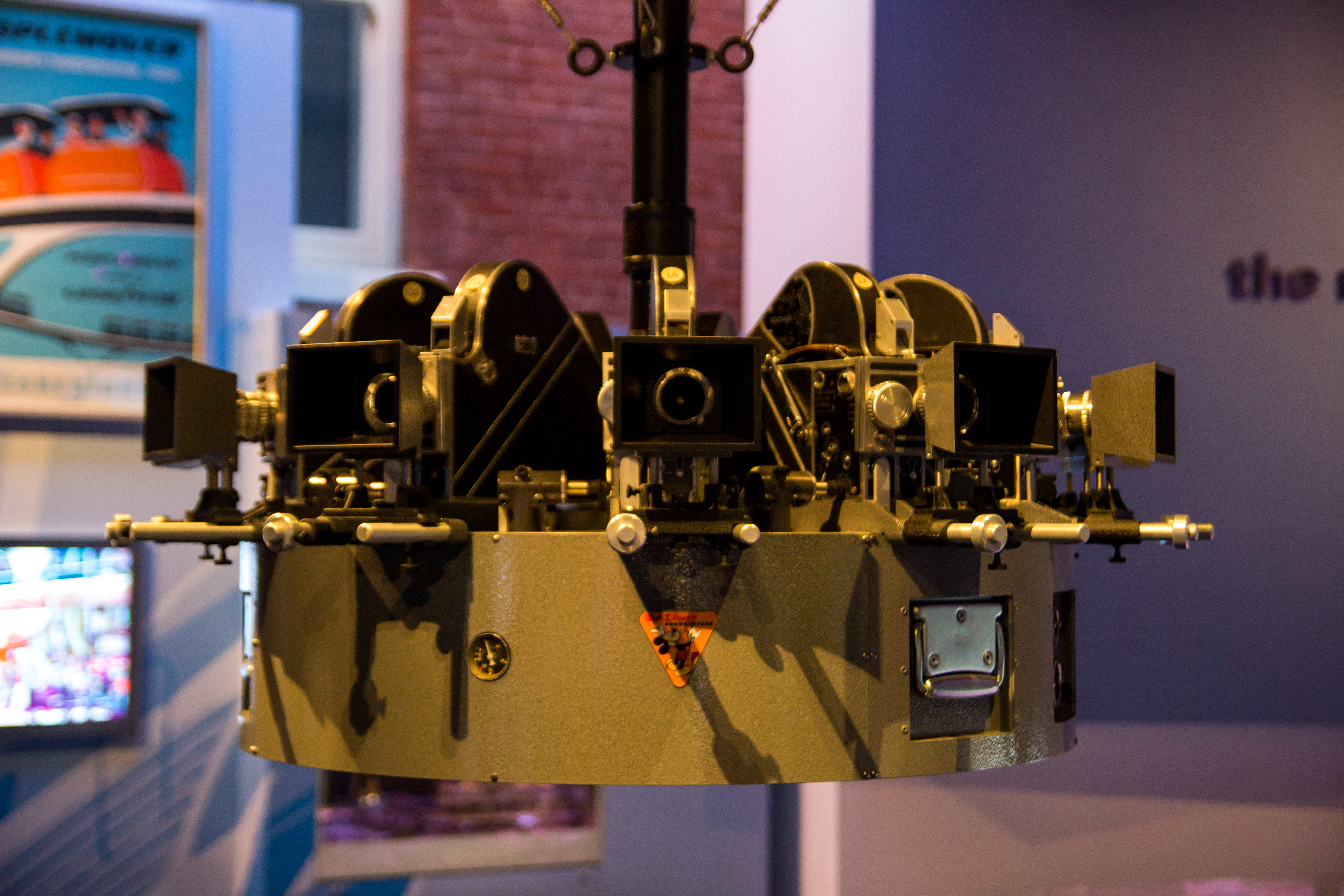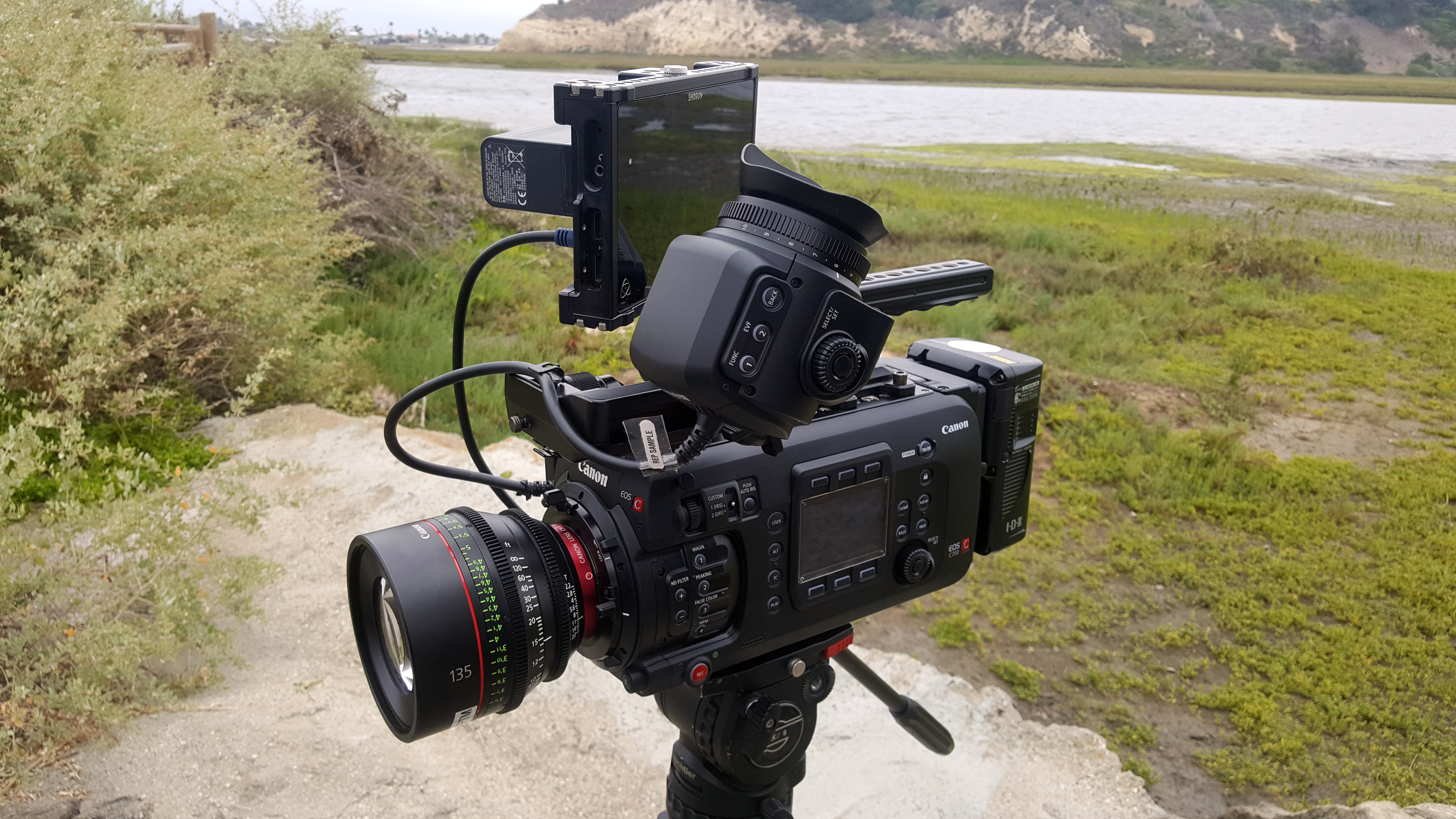|
Cinéorama
Cinéorama was an early film experiment and amusement ride presented for the first time at the 1900 Paris Exposition. It was invented by Raoul Grimoin-Sanson and it simulated a ride in a hot air balloon over Paris. It represented a union of the earlier technology of panoramic paintings and the recently invented technology of cinema. It worked by means of a circulatory screen that projects images helped by ten synchronized projectors. Grimoin-Sanson began experimenting with movie cameras and projectors in 1895 and was in contact with other early researchers such as Étienne-Jules Marey. He patented the Cinéorama on 27 November 1897. History In 1893, kinetoscope from Thomas Edison had been causing an enormous speculation between the other inventors, engineers and philosophers about the future of theater and narration. This invention let a single spectator see an image moving through a little spy hole in the top part. In the United States, Edison's new device was prote ... [...More Info...] [...Related Items...] OR: [Wikipedia] [Google] [Baidu] |
Exposition Universelle (1900)
The Exposition Universelle of 1900, better known in English as the 1900 Paris Exposition, was a world's fair held in Paris, France, from 14 April to 12 November 1900, to celebrate the achievements of the past century and to accelerate development into the next. It was held at the esplanade of Les Invalides, the Champ de Mars, the Trocadéro and at the banks of the Seine between them, with an additional section in the Bois de Vincennes, and it was visited by more than 50 million people. Many international congresses and other events were held within the framework of the Exposition, including the 1900 Summer Olympics. Many technological innovations were displayed at the Fair, including the '' Grande Roue de Paris'' ferris wheel, the ''Rue de l'Avenir'' moving sidewalk, the first ever regular passenger trolleybus line, escalators, diesel engines, electric cars, dry cell batteries, electric fire engines, talking films, the telegraphone (the first magnetic audio recorder), ... [...More Info...] [...Related Items...] OR: [Wikipedia] [Google] [Baidu] |
Raoul Grimoin-Sanson
Raoul Grimoin-Sanson (1860–1941) was an inventor in the field of early cinema. He was born in Elbeuf, as Raoul Grimoin; he added the surname Sanson later. He had an early interest in stage magic as well as photography. In the 1890s, Grimoin-Sanson began experiments in moving pictures, and desired to project films, like those from Thomas Edison's kinetoscope, on screen. In 1896, he invented a crude camera/projector combination called the Phototachygraphe. In 1897, he patented the Cinéorama, a panoramic film projection system involving ten synchronized projectors. The Cinéorama was demonstrated at the 1900 Exposition Universelle in Paris, but problems with heat from the projectors caused it to be shut down. Despite the failure of his Cinéorama company and of later film work, in the 1920s Grimoin-Sanson would attempt to claim to be one of the major pioneers of film, alongside Marey and the Lumières The Lumières (literally in English: ''The Lights'') was a cultura ... [...More Info...] [...Related Items...] OR: [Wikipedia] [Google] [Baidu] |
Circle-Vision 360°
Circle-Vision 360° is a film format developed by The Walt Disney Company that uses projection screens which encircle the audience. Circle-Vision 360° developed from the Circarama format, which uses eleven 16 mm projectors. The first Circarama film was '' A Tour of the West'' (1955). For the movie '' Italia '61'', the number of cameras was reduced to nine, and the 16 mm film was shown using 35 mm projectors. In 1965, Circle-Vision 360° made its official debut, in a nine-camera, 35 mm format. At least one reason for the renaming from Circarama was objections by the owners of Cinerama to the similarity between the two names. In both the Circarama and Circle-Vision 360° formats, the screens are arranged in a circle around the audience, with small gaps between the screens. The number of screens (eleven or nine) being odd results in a gap being opposite of each screen in the circle. The projectors are placed in these gaps, above the heads of the viewers. Railings are sometimes pr ... [...More Info...] [...Related Items...] OR: [Wikipedia] [Google] [Baidu] |
Movie Camera
A movie camera (also known as a film camera and cine-camera) is a type of photographic camera that rapidly takes a sequence of photographs, either on an image sensor or onto film stock, in order to produce a moving image to project onto a movie screen. In contrast to the still camera, which captures a single image at a time, by way of an intermittent mechanism, the movie camera takes a series of images; each image is a ''frame'' of film. The strips of frames are projected through a movie projector at a specific frame rate (number of frames per second) to show a moving picture. When projected at a given frame rate, the persistence of vision allows the eyes and brain of the viewer to merge the separate frames into a continuous moving picture. History An interesting forerunner to the movie camera was the machine invented by Francis Ronalds at the Kew Observatory in 1845. A photosensitive surface was drawn slowly past the aperture diaphragm of the camera by a clockwork mechanism to ... [...More Info...] [...Related Items...] OR: [Wikipedia] [Google] [Baidu] |
Panoramic Painting
Panoramic paintings are massive artworks that reveal a wide, all-encompassing view of a particular subject, often a landscape, military battle, or historical event. They became especially popular in the 19th century in Europe and the United States, inciting opposition from some writers of Romantic poetry. A few have survived into the 21st century and are on public display. Typically shown in rotundas for viewing, panoramas were meant to be so lifelike they confused the spectator between what was real and what was image. In China, panoramic paintings are an important subset of handscroll paintings, with some famous examples being '' Along the River During the Qingming Festival'' and ''Ten Thousand Miles of the Yangtze River''. History The word "panorama", a portmanteau of the Greek words ‘''pano''’ (all) and ‘''horama''’ (view), was coined by the Irish painter Robert Barker in 1787. While walking on Calton Hill overlooking Edinburgh, the idea struck him and he o ... [...More Info...] [...Related Items...] OR: [Wikipedia] [Google] [Baidu] |
70 Mm
70 mm film (or 65 mm film) is a wide high-resolution film gauge for motion picture photography, with a negative area nearly 3.5 times as large as the standard 35 mm movie film, 35 mm List of film formats, motion picture film format. As used in cameras, the film is wide. For projection, the original 65 mm film is printed on film. The additional 5 mm contains the four magnetic strips, holding six tracks of stereophonic sound. Although later 70 mm prints use digital sound encoding (specifically the DTS (sound system), DTS format), the vast majority of existing and surviving 70 mm prints pre-date this technology. Each frame is five Film perforations, perforations tall, with an aspect ratio (image), aspect ratio of 2.2:1. However, the use of Anamorphic format, anamorphic Ultra Panavision 70 lenses squeezes the image into an ultra-wide 2.76:1 aspect ratio. To this day, Ultra Panavision 70 produces the widest picture size in the history of filmmaking ... [...More Info...] [...Related Items...] OR: [Wikipedia] [Google] [Baidu] |
Tuileries Gardens
The Tuileries Garden (french: Jardin des Tuileries, ) is a public garden located between the Louvre and the Place de la Concorde in the 1st arrondissement of Paris, France. Created by Catherine de' Medici as the garden of the Tuileries Palace in 1564, it was eventually opened to the public in 1667 and became a public park after the French Revolution. Since the 19th century, it has been a place where Parisians celebrate, meet, stroll and relax. History The Italian Garden of Catherine de' Medici (16th century) File:Tuileries projet et jardins.jpg, Plan for the palace and gardens by Jacques I Androuet du Cerceau, 1576–1579 File:Map of Tuileries and Louvre, as in c. 1589.png, Plan of the Tuileries garden in about 1589. The Louvre is to the right In July 1559, after the accidental death of her husband, Henry II, Queen Catherine de' Medici decided to leave her residence of the Hôtel des Tournelles, at the eastern part of Paris, near the Bastille. Together with her son, the ... [...More Info...] [...Related Items...] OR: [Wikipedia] [Google] [Baidu] |
Spain
, image_flag = Bandera de España.svg , image_coat = Escudo de España (mazonado).svg , national_motto = '' Plus ultra'' ( Latin)(English: "Further Beyond") , national_anthem = (English: "Royal March") , image_map = , map_caption = , image_map2 = , capital = Madrid , coordinates = , largest_city = Madrid , languages_type = Official language , languages = Spanish , ethnic_groups = , ethnic_groups_year = , ethnic_groups_ref = , religion = , religion_ref = , religion_year = 2020 , demonym = , government_type = Unitary parliamentary constitutional monarchy , leader_title1 = Monarch , leader_name1 = Felipe VI , leader_title2 = Prime Minister , leader_name2 = Pedro Sánchez , legislature = ... [...More Info...] [...Related Items...] OR: [Wikipedia] [Google] [Baidu] |
Sahara
, photo = Sahara real color.jpg , photo_caption = The Sahara taken by Apollo 17 astronauts, 1972 , map = , map_image = , location = , country = , country1 = , country2 = , country3 = , country4 = , country5 = , country6 = , country7 = , country8 = , country9 = , country10 = ( disputed) , region = , state = , district = , city = , relief = , label = , label_position = , coordinates = , coordinates_ref = , elevation = , elevation_m = , elevation_ft = , elevation_ref = , length = , length_mi = , length_km = 4,800 , length_orientation = , length_note = , width = , width_mi = , widt ... [...More Info...] [...Related Items...] OR: [Wikipedia] [Google] [Baidu] |
Disneyland
Disneyland is a theme park in Anaheim, California. Opened in 1955, it was the first theme park opened by The Walt Disney Company and the only one designed and constructed under the direct supervision of Walt Disney. Disney initially envisioned building a tourist attraction adjacent to his studios in Burbank to entertain fans who wished to visit; however, he soon felt that the proposed site was too small. After hiring the Stanford Research Institute to perform a feasibility study determining an appropriate site for his project, Disney bought a site near Anaheim in 1953. The park was designed by a creative team hand-picked by Walt from internal and outside talent. They founded WED Enterprises, the precursor to today's Walt Disney Imagineering. Construction began in 1954 and the park was unveiled during a special televised press event on the ABC Television Network on July 17, 1955. Since its opening, Disneyland has undergone expansions and major renovations, including the a ... [...More Info...] [...Related Items...] OR: [Wikipedia] [Google] [Baidu] |






